Tsagaandelger, Dundgovi Province, Mongolia - Nine-year-old Bujinlkham Damdinsuren sits surrounded by her sisters inside her family's ger - the round, felt-sided tent where nomadic Mongolian families live. "I like to win," she says calmly of the 24-kilometre horse race in which she will compete the next day. The confident middle child in a family of three girls will be one of 50 competitors under the age of 12, and just three girls participating in the centuries-old, countrywide celebration known as Naadam, which includes archery and wrestling as well.
The whole family is inside the ger this morning. They live on the steppe of Dundgovi Province, 30km from the nearest town, surrounded by an arid landscape with views that go on for ever when not obscured by dust.
Bujinlkham with a heart-shaped face, wearing a sparkly Mickey Mouse shirt, plays a clapping game with her five-year-old sister Yanjinlkham, while her mother Muukhtsetseg rolls dough into discs, and her 15-year-old sister Namuunbaigal slices it into strips for fried noodles. Her father, Damdinsuren, wears a long burgundy tunic - called a deel - and weaves cowhide into a new whip for Bujinlkham.
Horses are pivotal in Mongolia's nomadic culture. "If we don't have horses, we're not Mongols," explains Damdinsuren. Bujinlkham has been training every dayfor the past month, sprinting her horses in the arid landscape where temperatures range from 30 degrees Celsius to -30 degrees Celsius during the year.
"We wish for her to come in the top five," says her father, looking up from weaving.
 |
| Bujinlkham Damdinsuren, right, inside her family’s ger in Dundgovi Province, Mongolia, with her sisters Namuunbaigal, centre, age 15, and Yanjinlkham, 5, top. Namuunbaigal used to compete in Naadam horse racing when she was younger, and Yanjinlkham hopes to compete next year [Hannah Griffin/Al Jazeera] |
Mongol traditionsBujinlkham and her sisters live in a country that has undergone rapid political, social and economic transformation since the peaceful 1990 democratic revolution in this former Soviet satellite state.
Yet cultural traditions remain strong. The families that remain out in the steppe maintain a nomadic lifestyle and their traditional values.
The girls and their father walk outside for Bujinlkham's final training ride. Damdinsuren lifts Bujinlkham into the saddle and she places her leather riding boots in the stirrups, singing softly. Bujinlkham rides as fast as she can through the steppe as her father and older sister trail behind on a motorcycle.
 |
| Damdinsuren sprints her horse on a final training ride before a 24km race the next day. Her father and older sister, both former horse racers, follow on a motorcycle [Hannah Griffin/Al Jazeera] |
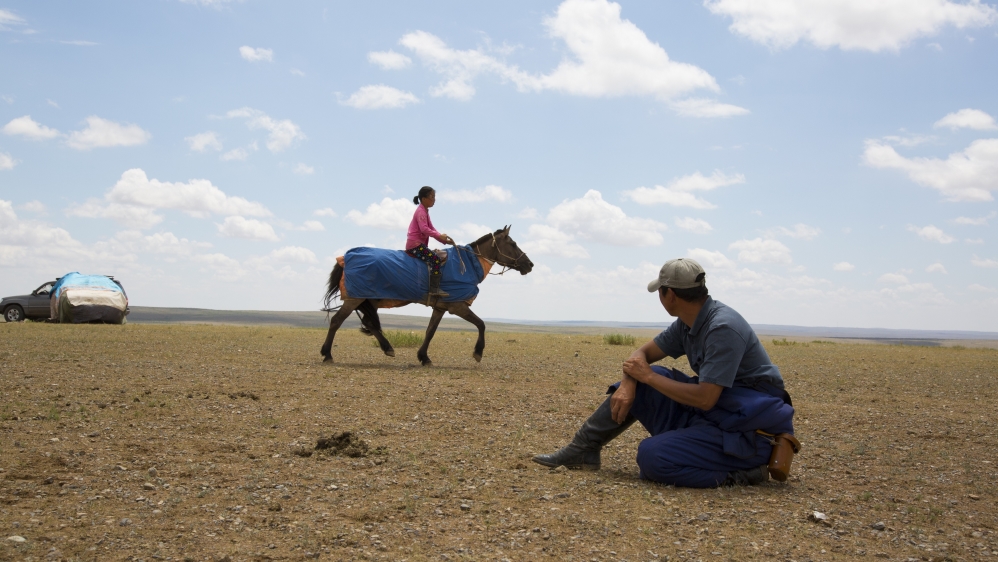 |
| Bujinlkham Damdinsuren’s father watches the nine-year-old as she begins her last training ride before she competes in a 24km horse race as part of Mongolia’s countrywide Naadam festival. Bujinlkham will be one of just three girls competing, and her family hopes she comes in the top five of 50 competitors [Hannah Griffin/Al Jazeera] |
Training stops mid-afternoon. It is election day and Bujinlkham's parents must travel to the nearby town of Tsagaandelger to vote. Mongolia has been a democracy for little more than a quarter-century, and many Mongolians take their voting seriously, often dressing formally and travelling long distances to cast a ballot.
Muukhtsetseg puts on a pair of strappy black heels before tying an orange sash around her husband's waist, and the pair bow out through the ger door amid requests for ice-cream from Bujinlkham and Yanjinlkham.
Bujinlkham curls up on the couch and pouts, while taking a photo with her sister's iPhone. The three girls are close, despite spending little time together during the year. Because the nomadic families live in remote areas where there are no schools in proximity, many children are forced to travel away and live with relatives or in dormitories near schools.
Bujinlkham lives with her grandparents and attends school there in a nearby town, and Namuunbaigal lives with another relative near her school outside the capital, Ulaanbaatar. Only Yanjinlkham spends all the year with her parents.
Mongolia has nine years of mandatory education requirement, and in the 2014-15 school year net enrolment was 99.1 percent in primary school. More girls than boys are enrolled in school, yet rural students such as the Damdinsuren sisters can be at a disadvantage in gaining access to higher education, largely due to the cost of living and housing in Ulaanbaatar, where the bulk of higher education institutions are located.Namuunbaigal, who loves her high-school science classes, hopes she can gain university education and become a doctor one day.
 |
| Yanjinlkham Damdinsuren, five, exercises one of her family’s horses as her sister trains for the 24km race the next day. Yanjinlkham hopes to compete next year [Hannah Griffin/Al Jazeera] |
The big dayOn the morning of the race, Bujinlkham quickly eats a bowl of salty leftover fried noodles, mutton and fresh cow's milk. She isn't nervous, but says she wishes there was an all-girls race.
The horses are boarded on to a truck and the family travels to Tsagaandelger, where the Naadam will be held. They arrive early, stopping at a relative's home. Bujinlkham quietly eats lunch, pulling cheek meat off of a leathery sheep's head sitting in the centre of the table, followed by dried cheese curds and milky tea.
A half-hour later Bujinlkham is on her horse, dressed in vivid yellow and ready to trot to the start line with the rest of the jockeys. The children line up before a steel gate. It drops, and the horses burst forward. Brothers and fathers run to their motorcycles and cars, accelerating to follow alongside the competitors during the 24km route.
 |
| Bujinlkham Damdinsuren awaits the start of the 24km race atop one of her family’s horses at a Naadam festival in Tsagaandelger, Mongolia [Hannah Griffin/Al Jazeera] |
Bujinlkham begins in last place. Her left hand grips the reins, while the right holds her new whip, arching overhead before each strike.
She sprints through the wall of dust kicked up ahead, and begins to pass riders until reaching the middle of the pack. She is alone for several kilometres in the open plain, until two boys quickly approach from behind. Bujinlkham nervously looks back at them and increases her pace, losing one and keeping the other at a safe distance.
She steadily holds her place in the middle of the pack, her tiny ponytail swaying. She crosses the finish line framed by spectators in pastel deels, coming in at 23rd place.
Bujinlkham stands dejected at the finish line beside her horse. She is disappointed with her performance. The family thinks an old leg injury on the horse may have affected the race. She doesn't linger long to speculate, hopping on the back of her older sister's motorcycle and speeding back to the relative's home to get changed.
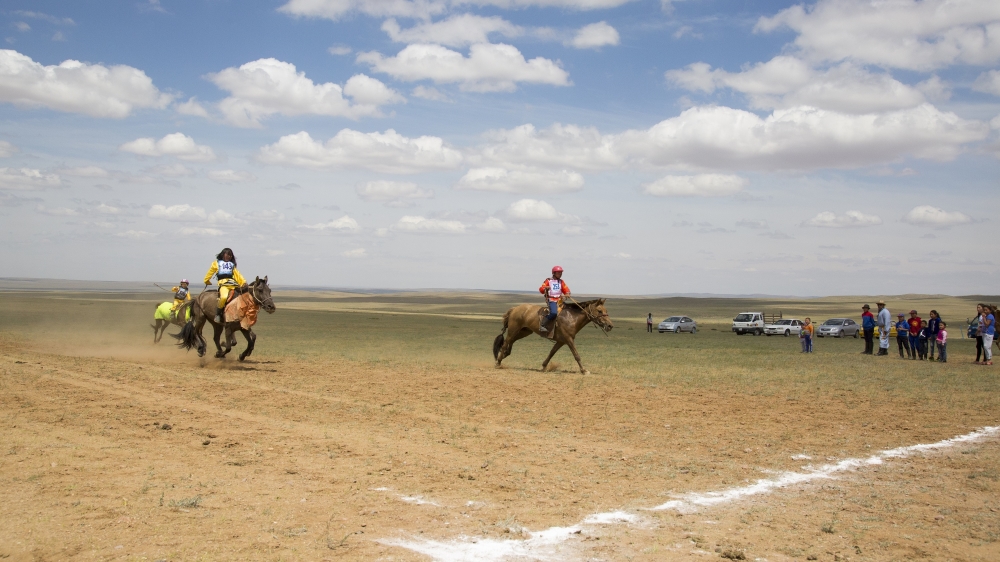 |
| Bujinlkham Damdinsuren approaches the finish line at the end of the 24km horse race [Hannah Griffin/Al Jazeera] |
A half-hour later she has calmed down, and she slowly dresses in the deel her mother sewed for her.
The family eats khuushuur - fried dough filled with mutton - and Bujinklham and her sisters run through the crowd, taking in the atmosphere of Naadam. Her mood lifts.
She admits she felt excited crossing the finish line, and wants to do even better next year. And when she returns to the start line in 2018, there may be four female competitors; five-year-old Yanjinlkham will work hard training this year to convince her parents she is also ready to race through the steppe atop one of the family's prized horses.
Photo Gallery: |
| Bujinlkham Damdinsuren outside her family’s ger in Dundgovi Province, Mongolia. Bujinlkham lives with a relative in a nearby town during the school year, as there is no school close to the family [Hannah Griffin/Al Jazeera] |
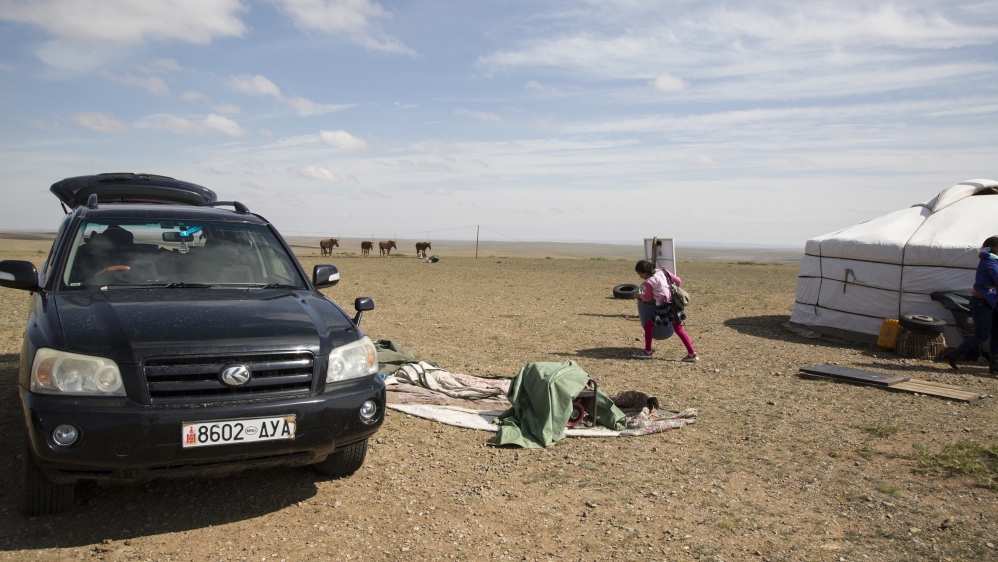 |
| Bujinlkham Damdinsuren packs her equipment on the race morning before her family drives 30km to Tsagaandelger, where the Naadam festival will take place [Hannah Griffin/Al Jazeera] |
 |
| Bujinlkham Damdinsuren and her sister Yanjinlkham feed their family’s horses [Hannah Griffin/Al Jazeera] |
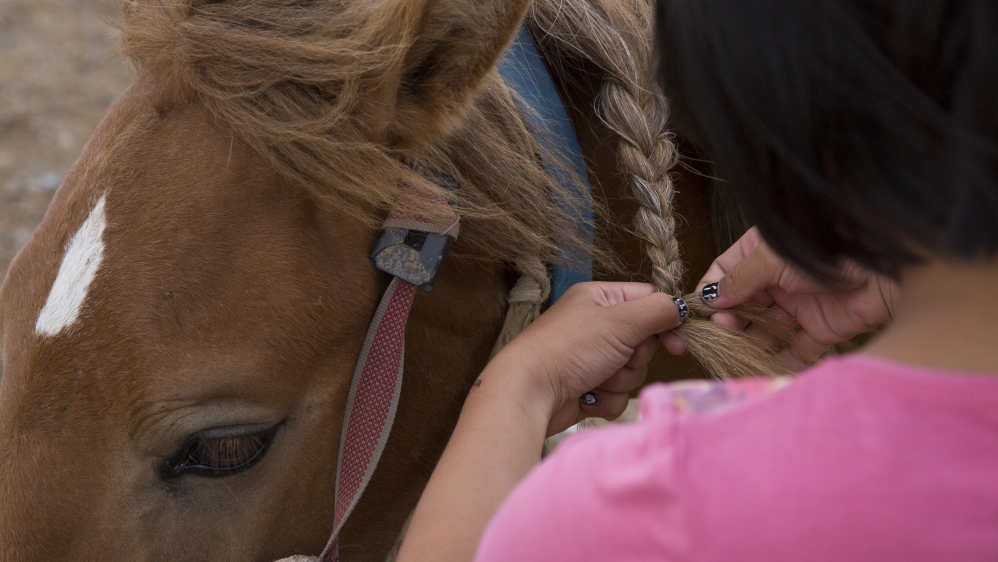 |
| Bujinlkham braids one of her family’s horse’s manes the evening before the Naadam horse race [Hannah Griffin/Al Jazeera] |
 |
| Bujinlkham Damdinsuren prepares a saddle for her horse during her last training ride before the 24km race [Hannah Griffin/Al Jazeera] |
 |
| Bujinlkham tries on a deel her mother, Muukhtsetseg, left, has sewn for her to wear during the Naadam festival [Hannah Griffin/Al Jazeera] |
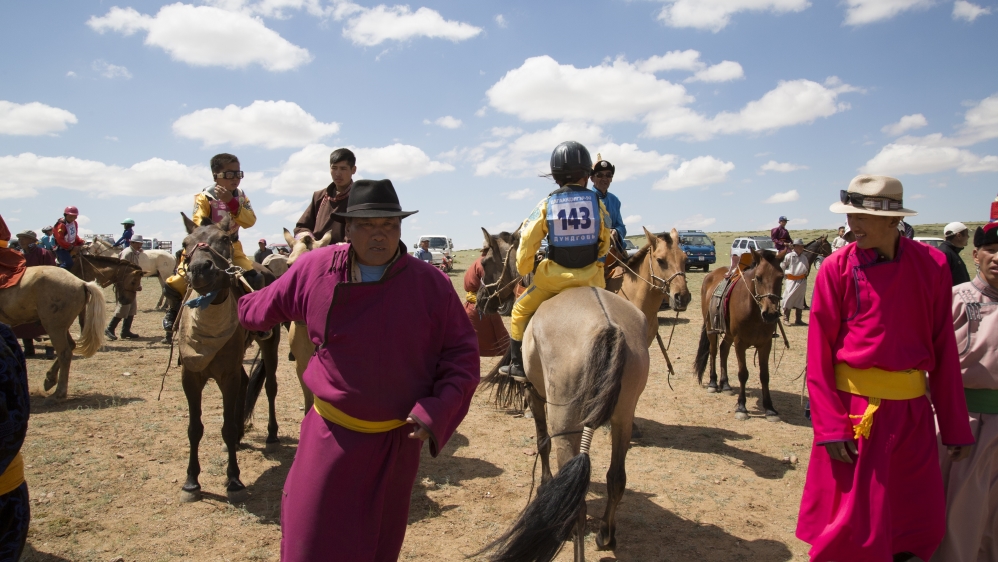 |
| Bujinlkham, dressed in yellow, awaits the start of the 24km race atop one of her family’s horses at the Naadam festival in Tsagaandelger [Hannah Griffin/Al Jazeera] |
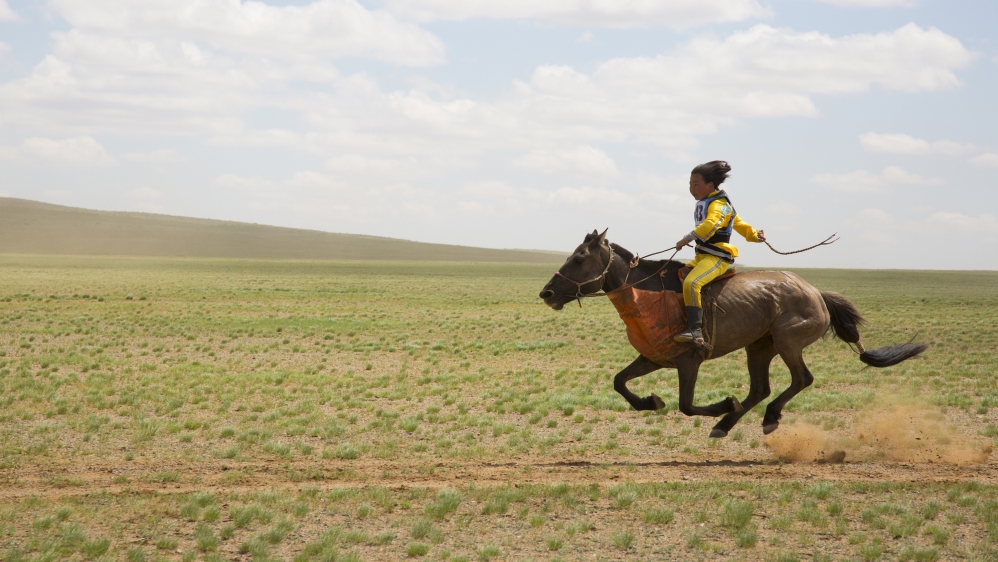 |
| Bujinlkham during the 24km horse race held as part of the Naadam festival [Hannah Griffin/Al Jazeera] |
 |
| Bujinlkham Damdinsuren holds her whip at the finish line at the end of the 24km race. She was disappointed with her 23rd place finish but will take part again next year [Hannah Griffin/Al Jazeera] |
Source: Al Jazeera News
